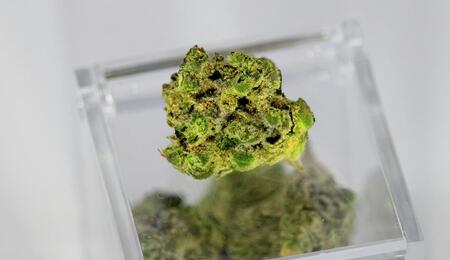The Science and Gadgets That are Reinventing Weed

Due to the law of averages and a relatively small set of variables, there is a very high chance that somewhere on the globe there is someone vaporising butane-extracted weed concentrate in a portable vape stick, made from plants that were grown under LED lights, all of which they purchased from the Deep Web. That person is the most up-to-date cannabis consumer out there.
But how did we get here, with such an ancient and, let's face it, broadly illegal commodity having its whole world, from growing to buying to consuming, overhauled by tech? Well, history is a little bit patchy on knowing when cannabis was first used as a narcotic – probably because anyone who did get high in the far reaches of history were too stoned to think about writing anything down.
One of the first accounts of people actually getting stoned comes from the 5th century BC, when a Greek historian by the name of Herodotus witnessed Scythian tribes from eastern Iran burning hemp under hot stones and breathing in the smoke, which he said would “make them drunk” before getting “more and more intoxicated until they jump up and start singing and dancing”.
Two-and-a-half-thousand years later and not a lot had changed for most of the world's population consuming cannabis for its therapeutic and recreational uses, legally or illegally. The overwhelming majority still put flame to plant and inhale the resulting smoke, whether that be with a joint, blunt, bong or chillum.
Zone in on the last decade or so, though, and things are changing dramatically in the world of weed. We can see how technologies have not only changed how people are getting high, but also the ways in which we harvest and trade the raw materials, too.
Growing up in the Spotlight
There are of course many countries in the world where weed is harvested outdoors in sunshine. Areas of India, Africa, the Americas, the Caribbean and the Far East can all reliably produce quality cannabis from the land alone. But for many, growing weed is an indoor activity, whether that's down to the climate not being right or the need to hide harvests from authorities.
When recreating Mother Nature indoors, the big lamp in the sky has to be replaced with electric lamps, illuminating crops of cannabis in anything from cupboards to warehouses. Ten years ago if you would have gone into a shop specialising in lightbulbs for indoor-growing operations, the most tried-and-tested options on offer were high-pressure sodium (HPS) and metal-halide (MH) bulbs. These are still the most widely used light-sources for indoor cannabis growing after gaining their popularity and reliability with growers over the last few decades.
But in more recent times these streetlights (literally, they are used to illuminate our roads) have had their dominance in cannabis-growing circles questioned by the power of lamps containing light-emitting diodes: the humble LED. Just as clunky cathode-ray tube televisions were superseded by sleek LED panels, an increasing number of growers are replacing cumbersome high-intensity discharge MH and HPS bulbs with large flat screens that contain LED clusters.
A lot of people would have first heard about them back in 2008, in a cover-story article entitled “Future Hydro” that was published in High Times magazine. The feature came bound with questions like: “Are LEDs the way of the future?”; with an adjacent advertisement hawking one of the early 'UFO' models strapped by the bold statements: “brightest LED on the planet”; “90 watts! No heat! Equivalent to a 600W”.
Such breathless advertising and future-gazing articles like this boasted early promise for LEDS. But many early adopters, likely well-versed in the world of MH and HPS bulbs, were not so impressed with these first-generation new-kids-on-the-block.
This would set the tone for the first few years of LED growlights' expansion in the world of indoor cannabis-growing. Scour any growers' forum on the topic, usually under titles like 'LED vs HPS', and you are met with page upon page of arguments defending either side of the divide: the outlay on an LED unit is far higher than a simple high-pressure bulb set-up; but HPS bulbs need changing every few grows, are fragile, and produce a larger heat-map than LEDs; you don't need expensive auxiliary equipment like a ballast and light-hood for an LED; HPS bulbs are tried and true; LED lightwave spectra are more suited to weed-growing; and on and on the discussions have gone during the growth in use of LEDs.
The most-current models pack LEDs with three-, five-, seven- or even 10-watts of output in each diode, which is a huge improvement on those first-generation UFOs. They shine so incredibly bright that growers often discuss the need to wear sunglasses when the lights are switched on. These lights are only going to keep evolving, with the next generation said to use bands of light-emitting polymers formed into large-surface-area strips, which glow when an electrical current is passed through them – like an LED but more futuristic.
Taking it All In
Now that we are illuminated on the most modern of grow-lighting techniques, let's look at the up-to-date ways that humans have found to gorge on ganja.
The Rise of Vaporisers
In 2014 'vape' became the Oxford Dictionary's word of the year, no doubt down to recent boom in use of portable vaporiser inhalator sticks that administer nicotine. In stoner circles, though, 'vaping' and vaporisers in various forms have been around for some time.
Cannabis vaporisation is essentially a process in which you heat the material at a lower temperature than combustion (burning). Typical heat ranges are between 120ºC – when the aromatic parts of the plant begin to vaporise – to 180ºC – at which point both the active THC and CBD components of the plant will have turned into a vapour. People often describe a vapour high from cannabis as more “clean” than smoking.
In the May 1989 edition of High Times, vaping pioneer Dr. Lunglife posed questions about the possibility of vaporising cannabis oil after experimenting with the process himself. Lunglife's questions and findings went mainly unanswered, says High Times, until the 7th annual Cannabis Cup that was held in Amsterdam in 1994. At the event a guy calling himself "Eagle Bill" had a vaporiser rig quite like modern table-top ones set up on his booth, giving out hits of vapour to attendees. Unsurprisingly, he was the most popular man at the event.
There is one model of table-top vaporiser that is more popular and iconic than the rest: the Volcano. It's the vaporiser of choice for Amsterdam coffee shops, as well as homes of weed-lovers around the world. Debuted at the turn of the millennia, the conical device is of the forced-air variety of vaporisers: an air pump drives the vapour into an inflating bag, which the user then detaches before squeezing the collected cloud into their mouth.
Volcano vapes and those of its ilk are getting on a bit now, and almost exactly in line with the rise in use of nicotine vaporisers, there has been a massive explosion in the market for handheld cannabis vaporiser sticks, which in most cases look exactly the same as a nicotine version. The worst ones take normal dried weed and don't even vaporise them: they overheat it and combust the material, making them essentially an electric pipe; the best ones take cannabis concentrates and truly vaporise the material.
Time to Concentrate
Many people will be familiar with hashish. It's the concentrated form of cannabis made by collecting resinous trichomes, which surround buds on a female, flowering weed plant. For centuries hash has been made in basic forms: pliable 'sticky' black resin that is made from plants that are fresher and the trichomes more soft, as is popular in India and Afghanistan; or harder, lighter in colour hashish that is produced from dried and pressed resin, as is produced in northern Africa, most notably Morocco.
In the last few decades these concentrates have evolved into substances that look positively futuristic when put next to their old-fashioned hashish counterparts – especially in the United States, where a huge move towards 'dabs' is taking place. We're not talking digital radios here: one only needs to take a 'dab', a very small amount, of the substance to achieve a high.
Dabs come in a variety of forms depending on their preparations. These concentrates go by intriguing, and usually rather descriptive, names: 'jelly', 'shatter', 'wax', 'honey oil', and 'budder', among others. The different consistencies and colours are caused by the extraction method used, as well as the different qualities of the raw plant matter used.
Of the varieties mentioned, 'shatter' is considered the best by connoisseurs. The pliable, sometimes more resistant, transparent substance is made through a complicated multi-phase process involving mixing plant material with butane, before vacuum-extracting the butane again and being left with a pure, clear 'glass-like' material. That's if you know what you're doing: it is an incredibly dangerous process, not one to be done by amateurs; rookies have blown themselves up when trying to make it.
Concentrates are becoming hugely popular in the US, more specifically in the states that have moved to legalise cannabis in the last few years: Colorado, Oregon and Washington. In a legal environment concentrates, especially butane-extracted ones, can be made in licensed laboratories by professionals. When made poorly there is butane left after inefficient extraction and the resulting product is dark and the flavour impaired.
Waiting for the Man (to Come Online)
You can buy practically anything online these days and drugs are no exception. Of course, a few grams of weed is hardly your average Amazon purchase; it's in the darker corners of the internet that people are stocking up on their narcotics.
Terms like Deep Web and Dark Net have come to the fore in the last couple of years as more people have become aware of the parts of the internet that cannot be accessed by normal search engines. Most will have heard claims in major news publications of being able to by hitmen, guns or porn, hidden behind a veil of intensely complicated encryption to keep it all secret. Drugs are a perfectly suited commodity to trade in these clandestine marketplaces.
One of the most noteworthy was Silk Road, its name referring to the ancient trade route that connected Europe to the Far East. Launched in 2011, the site became a bustling barter arena for cannabis and many other substances, all of which were paid for with the crypto-currency Bitcoin.
In 2013 the US Federal Bureau of Investigation (FBI) shut down the Silk Road, which quickly re-emerged as Silk Road 2.0. That too was banished by the FBI in 2014, along with a slew of other similar Deep Web trading ventures.
It's easy to see the appeal of purchasing goods through such portals: not having to buy drugs in person, where all sorts of risks arise, and a wide variety of choice from multiple vendors. Indeed, these two points alone drive the sustainment of these marketplaces.
It cannot be forgotten, though, that these hidden markets are realms of crime. Transactions are encrypted but having the illicit goods delivered is risky business, whether that be paying for products that don't arrive (though some vendors operate pay-on-confirmed delivery), or worse: authorities intercepting the package and delivering it themselves with handcuffs attached.
Popping round to a dealer's flat for quick chat and bag of bud might not be so bad after all.
Source: Gizmodo



